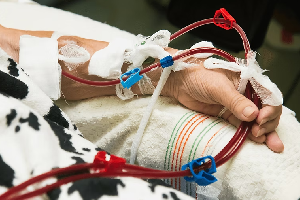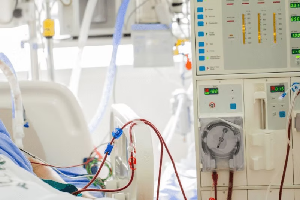Dialysis
Dialysis is a life-saving treatment for individuals with kidney failure,
a condition where the kidneys are no longer able to filter waste
products and excess fluids from the blood effectively. This procedure
replicates many of the kidneys' functions, helping to maintain balance
in the body and prevent complications associated with kidney failure.
What is Dialysis?
Dialysis is a medical procedure that removes waste products and excess
fluids from the blood when the kidneys are no longer able to perform
these functions naturally. It is typically required for patients with
end-stage renal disease (ESRD) or severe chronic kidney disease (CKD).
There are two main types of dialysis:
- 1.Hemodialysis
- 2.Peritoneal Dialysis
Types of Dialysis
1. Hemodialysis:
Hemodialysis uses a machine and a filter, known as a dialyzer, to clean the
blood. The process involves:
- Access to the Bloodstream: This is typically achieved
through a fistula (an artery and vein joined together under the skin) or a
graft (a plastic tube that connects an artery and a vein).
- Dialysis Process: Blood is pumped from the body to the
dialyzer, where it passes through a semipermeable membrane. Waste products
and excess fluids move from the blood into a dialysis solution (dialysate)
and are removed from the body.
- Frequency: Hemodialysis is usually performed three times a
week, with each session lasting about 3-5 hours..
2. Peritoneal Dialysis:
Peritoneal dialysis uses the lining of the abdomen (the peritoneum) as a natural
filter. The process involves:
- Access to the Abdomen:A catheter is surgically placed in
the abdomen.
- Dialysis Process: Dialysis solution is infused into the
abdominal cavity through the catheter. Waste products and excess fluids pass
from the blood vessels in the peritoneum into the dialysate. After a dwell
time, the used solution is drained and replaced with fresh dialysate.
Types of Peritoneal Dialysis:
- Continuous Ambulatory Peritoneal Dialysis (CAPD):Manual
exchanges are done several times a day.
- Automated Peritoneal Dialysis (APD): A machine performs
exchanges overnight while the patient sleeps.
Choosing the Right Type of Dialysis
The choice between hemodialysis and peritoneal dialysis depends on
several factors, including the patient’s medical condition, lifestyle
and personal preferences.
Our healthcare provider can help determine the best option based on
individual needs and circumstances.
Living with Dialysis
Dialysis requires significant lifestyle adjustments, but many patients
continue to lead active, fulfilling lives. Key aspects of managing life
with dialysis include:
- Diet and Nutrition: Following a special diet to
manage fluid and electrolyte balance.
- Medications:Taking prescribed medications to
control blood pressure, anemia, and other complications.
- Regular Monitoring:Attending scheduled dialysis
sessions and medical appointments to monitor health status and
adjust treatments as necessary.
- Support Systems: Engaging with healthcare providers
to address the emotional and psychological aspects of living with
dialysis.



